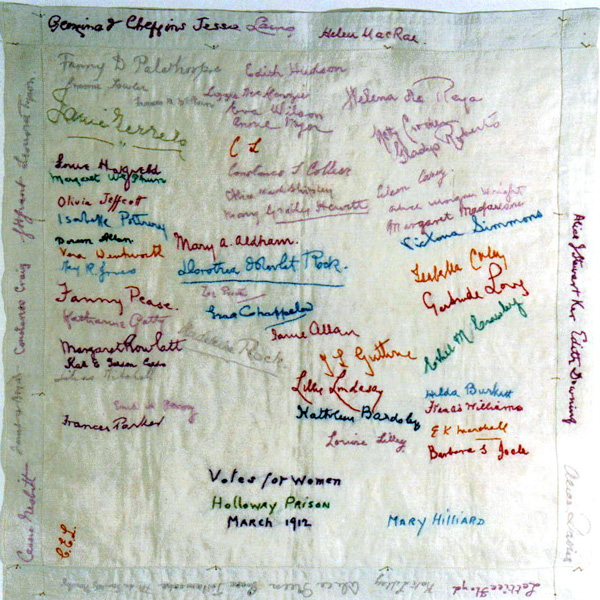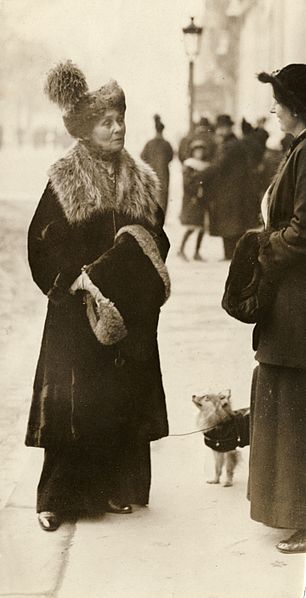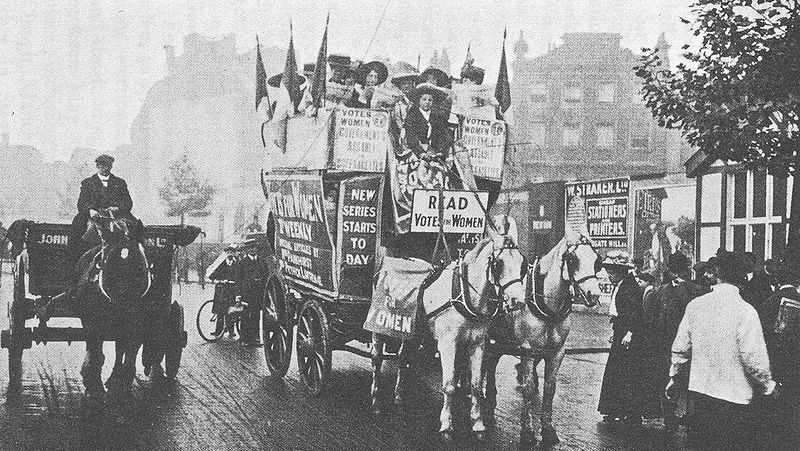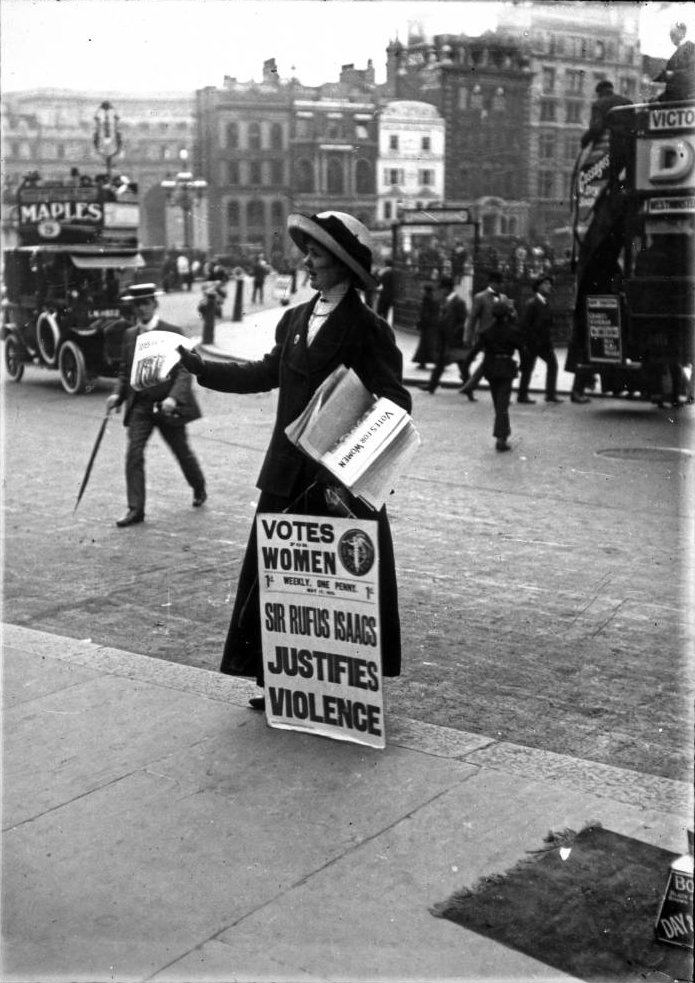“We have to free half of the human race, the women, so that they can help to free the other half” – Emmeline Pankhurst

June the 8th is fast approaching – the day the British public go to the polls…. Being a woman of middling years, this is something I have done on numerous occasions in the past…. I recall the very first time I exercised my right to vote; I was in my late teens, I stopped off at the village hall on my way to work, I felt so very grown-up. That time and every subsequent time since, that I have pencilled my ‘X’ into the appropriate box, I have had no doubt as to which Party I wished to vote for; it has always been perfectly clear in my mind – until now…. For the first time in my life, I am questioning – to the point I have even asked myself whether I should bother to vote at all….
************************
A couple of years ago, John and I visited the Priest House at West Hoathly in West Sussex; a traditional Wealdon hall house, situated on the edge of Ashdown Forest, it is a museum filled with some of the most amazing artifacts from life gone by. One particular item really caught my eye – a framed handkerchief covered with signatures. On closer inspection it became evident that each signature had been painstakingly embroidered. The delicate piece of linen is known as ‘The Suffragette Handkerchief’ and bears 66 signatures and 2 sets of initials; I was fascinated and bought myself a pamphlet explaining its history and meaning…. Last week, whilst doing a spot of spring cleaning, I came across this pamphlet….it seemed poignant that I should unearth it at this particular point in time…. The signatures are those of a group of women that were being held in Holloway Prison in 1912 – when the Women’s Suffrage Movement was at its peak….

After the industrial revolution many women were in the position of being in full-time employment. Although actively contributing to the Country’s workforce they had no voice in the running of the Nation – no representation in Parliament and indeed, were not even allowed to vote. Organised campaigns for women’s suffrage started to materialise in 1866 and by 1888 women were permitted to vote in many council elections – but that was as far as it went…. In 1867, Liberal MP, John Stuart Mill proposed an amendment to give women the vote on the same terms as those of men…. It was rejected by 194 to 73 – and so the ‘Cause’ gained momentum….by the end of the 19th Century the focus of women’s equality became that of their right to vote….
The National Union of Women’s Suffrage Societies (NUWSS), known as the ‘Suffragists’ (not to be confused with suffragettes) was founded in 1897. It was a merger of two groups that had both split up in 1888; the National Central Society for Women’s Suffrage and the Central Committee, National Society for Women’s Suffrage. The aim of the NUWSS was to lobby and obtain the vote for women through democratic, legal and peaceful means…. Its members were middle class and working class women, working together, alongside each other….and it wasn’t only confined to women, many men also actively campaigned for the Cause…. By 1914 it had over 100,000 members and 500 branches countrywide….
In 1903 the Women’s Social Political Union (WSPU) was founded by six women in Manchester. Dissatisfied with the results being achieved by the NUWSS, this new group decided more militant tactics were needed. The women only group, under the leadership of Emmeline Pankhurst and her daughter, Christabel, fought for social reforms and became known as the ‘Suffragettes’….adopting the slogan “Deeds, not words”….

In November 1911, demonstrations in London saw the arrest of 223 women, after a spree of window breakages of government buildings in Whitehall and at shops in the Strand. March 1912 saw an even bigger demonstration, a second wave of window smashing in London, organised by the WSPU, meant a further 200 plus women were arrested. The leaders of the WSPU, including Emmeline Pankhurst, were sentenced to nine months in prison; other women received sentences averaging two months – many for refusing to pay fines levied in Court….


Soon, Holloway became full, so women were sent to other prisons in places such as Birmingham and Aylesbury. Overcrowding meant the conditions in the prisons were even poorer than usual. Denied the status of political prisoners and so not receiving the certain privileges that such were entitled to, many of the women resorted to going on hunger strike as a protest….

The pamphlet I found whilst spring cleaning recites the story of how this particular group of women happened to be in Holloway at the time and the author had researched the women whose names appear on the handkerchief. They came from all over the Country and from all walks of life. After reading through the explanation and the information collected on each woman, it inspired me to find out a bit more about women’s suffrage closer to home….

Here in Surrey, the Movement appears to have become active in the 1870s. The first recorded meeting was held in Guildford during January 1871. Farnham had a branch of the NUWSS from 1908 and by 1909 the Godalming branch had been established. Godalming’s president was Mrs. Mary Watts, the widow of the artist G.F.Watts. Her secretary, Theodora Powell, went on to co-found the Guildford branch in 1910, (Cranleigh also got its own branch in this same year). Connected to the Godalming branch was a New Zealander by the name of Noeline Baker, who befriended famous garden designer, Gertrude Jekyll (who lived just outside of Godalming). Jekyll became a member of the NUWSS and designed banners for both the Godalming and Guildford branches….
The Church in Surrey provided sympathisers to the Cause. One clergyman in particular, involved in the League for Women’s Suffrage, was a Reverend Algernon Creed, vicar of Ewshot, near Farnham. This particular piece of information struck a chord with me; I spent my teenage years in Ewshot, living in a house opposite the church…. I got married in that church, my son was christened there and it is where we said ‘good-bye’ to my father after he passed away. A humble church in a small Surrey village, I had no idea such an advocate for women’s equality had once been such an important part of it….
By 1913 all areas of the Country had representation in organisations promoting the suffrage cause. Surrey saw its fair share of militant activism; one method was to sabotage male dominated organisations, golf courses and cricket grounds were popular choices. Sometimes more extreme measures were attempted, for example a bomb left at Haslemere Station (which failed to ignite)….


Many suffragettes had homes in the Surrey Hills, amongst them Emmeline and Frederick Pethick-Lawrence, who helped lead the WSPU. Their home, ‘The Mascot’, in South Holmwood, became the place where many women released from prison after being on hunger strike, went to recuperate….

Peaslake, a village in the Surrey Hills, was home to a surprisingly large number of activists, it was described in 1912 as being “rather a nest of suffragettes”….
Hilda Brackenbury and her daughters Georgina and Marie also opened their home, ‘Brackenside’, in Peaslake, to women recovering from hunger strike….including Emmeline Pankhurst herself. In fact, it was a Peaslake resident, Marion Wallace Dunlop – an artist, sculptor and illustrator – who initiated the very first hunger strike….
Marion Wallace Dunlop, a member of the WSPU, was imprisoned for printing an extract from the bill of rights on the walls of St. Stephen’s Hall at the House of Commons. On the 5th July, 1909, she went on hunger strike, refusing all food as a protest that her rights as a political prisoner were not recognised. She claimed her actions were “….a matter of principle, not only for my own sake but for the sake of others who may come after me….refusing all food until this matter is settled to my satisfaction….” After three days of fasting….she was released….


Force feeding was a brutal procedure. The woman was either tied to a chair, which was then tipped back or she was held down on a bed. A rubber tube was then forced up the nose or down the throat, into the stomach. If administered via the mouth, a ‘gag’ was used, occasionally made of wood but more often steel. The steel option was particularly painful as it was pushed into the mouth to force open the teeth and then a screw was turned to open the jaws wide…. Sometimes the rubber tube would be accidentally forced into the windpipe, causing food to enter the lungs, thus endangering life…. Which ever method was used, damage to the nose or throat was pretty much inevitable….

Some women had to endure being force-fed more than 200 times…. Two such women were Grace Roe and Kitty Marion….
Grace Roe joined the WSPU after hearing Emmeline Pethick-Lawrence speak in October 1908. Grace was arrested for the first time after a demonstration held at the House of Commons on June 29th, 1909. She was appointed organiser of the East Anglia WSPU in 1910 and then in 1912 Emmeline Pankhurst made her deputy of the WSPU in London, under Annie Kenney. After Kenney’s arrest and imprisonment for ‘incitement to riot’ in April 1913, Grace became leader of the WSPU in London….


Katherina Schafer was born in Westphalia, Germany in 1871. Her mother died when she was just two years old, her father remarried but lost his second wife when Katherina was only six; both women died of TB. Katherina’s father was very strict and by all accounts had an uncontrollable temper…. In 1886 the young Katherina moved to England to join her sister, Dora. She learnt English, changed her name to Kitty Marion and became an actress, enjoying a successful although modest career. In 1908 she joined the WSPU, moved to Hartfield, East Sussex and became an active member of the Brighton branch….
In June 1908 Kitty was arrested at a demonstration at the House of Commons. In July 1909 she was arrested once again; this time she was imprisoned. She immediately went on hunger strike which resulted in her being force-fed. In retaliation and protest she barricaded herself in her cell and set light to her mattress….
In November 1911, she was once again sent to prison, with a sentence of 21 days to be served in Holloway, she went on hunger strike yet again…. It has been calculated that Kitty endured some 232 force feedings during the times she spent on hunger strike in prison….
This account by Kitty Marion, from 1913, has been edited by Christabel Pankhurst. The excerpt is taken from ‘The Suffragette’ – the official weekly newspaper of the WSPU….
….”I was lying on my bed, and I immediately turned to the wall, but they wheeled the bed out into the middle of the room, and tried to get me into position for feeding. I struggled violently, but they sat on my legs and I was fed with the nasal tube. I was so exhausted at the end of the feeding that a wardress was left with me for some time”….
The following account is that of E.Sylvia Pankhurst (daughter of Emmeline). The excerpt is as published in McClure’s magazine, August 1913 pp 87-93…. Please be advised, it is quite graphic….
….”I struggled as hard as I could, but they were six and each one of them much bigger and stronger than I. They soon had me on the bed and firmly held down by the shoulders, the arms, the knees and the ankles.
Then the doctors came stealing in behind. Some one seized me by the head and thrust a sheet under my chin. I felt a man’s hands trying to force my mouth open. I set my teeth and tightened my lips over them with all my strength. My breath was coming so quickly that I felt as if I should suffocate. I felt his fingers trying to press my lips a part, -getting inside,- and I felt them and a steel gag running around my gums and feeling for gaps in my teeth.
I felt I should go mad; I felt like a poor wild thing caught in a steel trap. I was tugging at my head to get it free. There were two of them holding it. There were two of them wrenching at my mouth. My breath was coming faster and with a sort of low scream that was getting louder. I heard them talking : “Here is a gap”.
“No, here is a better one – this long gap here”.
Then I felt a steel instrument pressing against my gums, cutting into the flesh, forcing its way in. Then it gradually prised my jaws a part as they turned a screw. It felt like having my teeth drawn; but I resisted – I resisted. I held my poor bleeding gums down on the steel with all my strength. Soon they were trying to force the india-rubber tube down my throat.
I was struggling wildly, trying to tighten the muscles and to keep my throat closed up. They got the tube down, I suppose, though I was unconscious of anything but a mad revolt of struggling, for at last I heard them say, “That’s all”; and I vomited as the tube came up.
They left me on the bed exhausted, gasping for breath and sobbing convulsively. The same thing happened in the evening; but I was too tired to fight so long.
Day after day, morning and evening, came the same struggle. My mouth got more and more hurt; my gums, where they prised them open, were always bleeding, and other parts of my mouth got pinched and bruised.
Often I had a wild longing to scream, and after they had gone I used to cry terribly with uncontrollable noisy sobs; and sometimes I heard myself, as if it were some one else, saying things over and over again in a strange, high voice.
Sometimes – but not often; I was generally too much agitated by then – I felt the tube go right down into the stomach. It was a sickening sensation. Once, when the tube had seemed to hurt my chest as it was being withdrawn, there was a sense of oppression there all the evening after, and as I was going to bed I fainted twice. My shoulders and back ached very much during the night after the first day’s forcible feeding and often afterwards.
But infinately worse than any pain was the sense of degradation, the sense that the very fight that one made against the repeated outrage was shattering one’s nerves and breaking down one’s self control”…. – E.Sylvia Pankhurst
The act of force feeding was highly controversial, causing a public outcry. In 1913 the government looked to other ways of dealing with the hunger strike issue and introduced the Temporary Discharge for Ill-Health Act, which became known as the Cat and Mouse Act. This in itself could be regarded almost as cruel as the force feeding itself…. It allowed the release of a hunger striker in order for her to recuperate and regain her health…. Once recovered, she would then be re-arrested and made to complete her sentence….
Between 1900 and the start of World War 1 approximately 1,000 people were imprisoned for crimes relating to suffrage. Most were sent to prison for refusing to pay fines imposed by the Courts as punishment….
The subject of women’s suffrage was debated in the House of Commons 18 times between 1870 and 1904. Many suffrage societies suspended their activities at the beginning of WW1. Two million women took up and worked in roles traditionally fulfilled by men; this was to become a key factor in women finally obtaining the vote….

In February 1918, the Representation of the People Act was passed awarding the vote to women aged 30 or over, if they were a householder or the wife of one. This excluded the majority of working class women and fell well short of the original aims of the suffrage campaign….
In November 1918 the Parliament (Qualification of Women) Act was passed, allowing women to stand for Parliament. The first ever elected female MP was Constance Markievicz for Sinn Fein but she did not ever take her seat. In 1919, Lady Nancy Astor became the first female MP to sit in the House of Commons….
On the 14th December, 1918, 8.5 million women were eligible to vote in a general election for the first time. It wasn’t until 1928 with the Representation of the People (Equal Franchise) Act that women were given the same equal voting rights as men: the general election of May 1929 saw 15 million women with the right to vote….
So, with all that in mind, I for one have been reminded why I have always felt it my duty as a woman to vote; in recognition of our sisters who fought so hard to secure it for us. Far be it for me to preach to anyone but I hope it’s given you food for thought, girls….as it has for me…. This Country may be facing difficult times and some of us may be having problems deciding which way to vote or whether to even bother….but don’t you think we owe it to these women to do so….? I’m glad I came across that pamphlet….


Oh my goodness, what an incredibly moving and thought-provoking piece of writing. I’m so grateful to you for posting this, Hazel. I’ve never missed a vote and neither have my three daughters (aged 32, 30 and 24) – we all feel really strongly that to do so would be to further abuse these brave women. Thank you x
LikeLike
These are really impressive ideas in regarding blogging. You have touched some good points here. Any way keep up wrinting.
LikeLike
Fabulous, what a weblog it is! This blog gives valuable data to us, keep it up.|
LikeLike
Thank you – it is so lovely to get feedback like this & know people are enjoying what I love doing… I’m fairly new to blogging & comments like this are so encouraging….
LikeLike
Do you mind if I quote a couple of your posts as long as I provide credit and sources back to your site? My blog site is in the very same area of interest as yours and my users would genuinely benefit from some of the information you present here. Please let me know if this alright with you. Thanks a lot!|
LikeLike
Hi there, sorry for the delay in getting back, only just picked this up… Please feel free to use anything you want….we bloggers should all be here to help and support each other…. good luck…
LikeLike
I pay a quick visit every day a few blogs and sites to read posts, however this web site gives feature based writing.|
LikeLike
Thank you for the encouragement – I’m fairly new to blogging & it’s lovely to get feedback like this & know it’s being read…
LikeLike
We’re a group of volunteers and opening a new scheme in our community. Your website provided us with valuable information to work on. You’ve done a formidable job and our whole community will be thankful to you.|
LikeLike
Thank you, it encourages me to know people are reading the blog… feedback like this is invaluable… good luck with your work…
LikeLike
Howdy! Do you use Twitter? I’d like to follow you if that would be okay. I’m undoubtedly enjoying your blog and look forward to new updates.|
LikeLike
Hi there, Cottage Capers is on Twitter @CapersCottage – look forward to meeting you there…. (alternatively you can follow via email, sign up & you will be alerted when new blogs are posted)… Thank you for taking the time to read the blog….it’s lovely to get feedback & know people are enjoying reading it as much as I enjoy writing it…
LikeLike